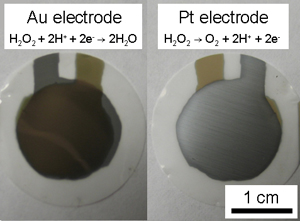Self-pumping membrane mimics cell machinery
21 September 2010
US researchers have imitated the transport functions of biological membranes by incorporating tiny pumps into synthetic membranes. They say their 'self-pumping' mimics could be used in compartment-less fuel cells.
In nature, the membranes that hold cells together contain channel proteins responsible for letting ions in and out. Some specialist channel proteins use adenosine triphosphate (ATP) - the main source of chemical energy in cells - to drive ions against the concentration gradient.
Henry Hess at Columbia University in New York and In-Kook Jun at the University of Florida have now designed a polycarbonate membrane with a built-in pump action that's driven, like in nature, by chemical energy. Their synthetic version gets its energy not from ATP but from hydrogen peroxide.
'We're not doing exactly what biological membranes do, but it's the first time to my knowledge that you have a membrane that harvests its fuel from the solution and then converts it into mechanical work for pumping,' says Hess. 'So this membrane pumps by itself - it doesn't need a power supply from the outside.'

Gold and platinum electrodes are deposited on the opposing surfaces of a polycarbonate membrane to form the self-pumping membrane © Advanced Materials |
Hess and Jun sandwiched their membrane between gold and platinum electrodes. On the platinum side, hydrogen peroxide splits to form oxygen molecules, hydrogen ions and electrons. The electrons flow between the two electrodes, while the hydrogen ions are pumped through 1µm wide pores towards the gold electrode. Unlike in regular fuel cells, which use ion exchange membranes to keep the solutions surrounding cathode and anode from mixing, there is no need to create separate compartments. Instead, voltage is generated simply by immersing the electrode-coated membrane in hydrogen peroxide.
'The paper shows an inventive use of chemical versus external electrical power to sustain current through an electroosmotic pump. This makes it interesting and novel,' says Juan Santiago, a microfluidics expert at Stanford University, California. 'Practically, though, the pump has low performance - I think it's unlikely to be useful in fuel cells.'
Hess admits their current design is a very crude first effort, but says the novelty is in the combination of electroosmotic pump and fuel cell. 'If you think hard enough about it you can make a much better fuel cell or a much better electroosmotic pump, but so far nobody has put these things together.'
The team is now working on getting the membranes to run on glucose, which would have the added advantage of making them biologically compatible, meaning they could eventually also be used in implants, for example to improve blood circulation.
Hayley Birch
Interesting? Spread the word using the 'tools' menu on the left.
References
I-K Jun and H Hess, Adv. Mater., 2010, DOI: 10.1002/adma.201001694
